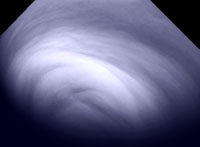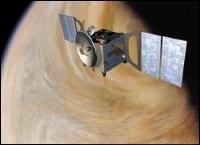Venus holds warning for Earth
30 November 2010
A mysterious high-altitude layer of sulphur dioxide discovered by ESA's Venus Express has been explained. As well as telling us more about Venus, it could be sending a warning to those on Earth seeking to inject our atmosphere with sulphur droplets in an attempt to mitigate climate change.Venus is blanketed in sulphuric acid clouds that block our view of the surface. The clouds form at altitudes of 50–70 km when sulphur dioxide from volcanoes combines with water vapour to make sulphuric acid droplets. Any remaining sulphur dioxide should be destroyed rapidly by the intense solar radiation above 70 km.
So the detection of a sulphur dioxide layer at 90–110 km by ESA's Venus Express orbiter in 2008 posed a complete mystery. Where did that sulphur dioxide come from?
Now, computer simulations by Xi Zhang, California Institute of Technology, USA, and colleagues from America, France and Taiwan show that some sulphuric acid droplets may evaporate at high altitude, freeing gaseous sulphuric acid that is then broken apart by sunlight, releasing sulphur dioxide gas.
 |
|
Close-up on Venusian cloud structures at the south pole. |
As well as adding to our knowledge of Venus, this new understanding may be warning us that proposed ways of mitigating climate change on Earth may not be as effective as originally thought.
Nobel prize winner Paul Crutzen has recently advocated injecting artificially large quantities of sulphur dioxide into Earth's atmosphere at around 20 km to counteract the global warming resulting from increased greenhouse gases.
 |
|
Illustration of Venus Express. Credit: ESA |
However, the new work on the evaporation of sulphuric acid on Venus suggests that such attempts at cooling our planet may not be as successful as first thought, because we do not know how quickly the initially protective haze will be converted back into gaseous sulphuric acid: this is transparent and so allows all the Sun's rays through.
"We must study in great detail the potential consequences of such an artificial sulphur layer in the atmosphere of Earth," says Jean-Loup Bertaux, Université de Versailles-Saint-Quentin, France, Principal Investigator of the SPICAV sensor on Venus Express. "Venus has an enormous layer of such droplets, so anything that we learn about those clouds is likely to be relevant to any geo-engineering of our own planet."
In effect, nature is doing the experiment for us and Venus Express allows us to learn the lessons before experimenting with our own world.
Related publications
Photolysis of sulphuric acid as the source of sulphur oxides in the mesosphere of Venus, by Xi Zhang, Mao-Chang Liang, Franck Montmessin, Jean-Loup Bertaux, Christopher Parkinson and Yuk L. Yung, is published in Nature Geoscience today.Notes for editors
Venus Express's instrument SPICAV stands for Spectroscopy for Investigation of Characteristics of the Atmosphere of Venus.
For more information:
Markus Bauer
ESA Science and Robotic Exploration Communication Officer
Tel: +31 71 565 6799, +31 61 594 3 954
Email: markus.bauer esa.int
esa.int
Håkan Svedhem
ESA Project Scientist Venus Express
Email: H.Svedhem esa.int
esa.int
Jean-Loup Bertaux, SPICAV Principal Investigator
LATMOS, Université de Versailles-Saint-Quentin, France
Tel: +33 1 80 28 50 62, +33 6 80 73 08 70
Email: jean-loup.bertaux latmos.ipsl.fr
latmos.ipsl.fr
Colin F. Wilson
Oxford University, UK
Tel: +44 1865 272 086
Email: wilson atm.ox.ac.uk
atm.ox.ac.uk
(Note: This article was originally published on ESA's Space Science Portal.)

